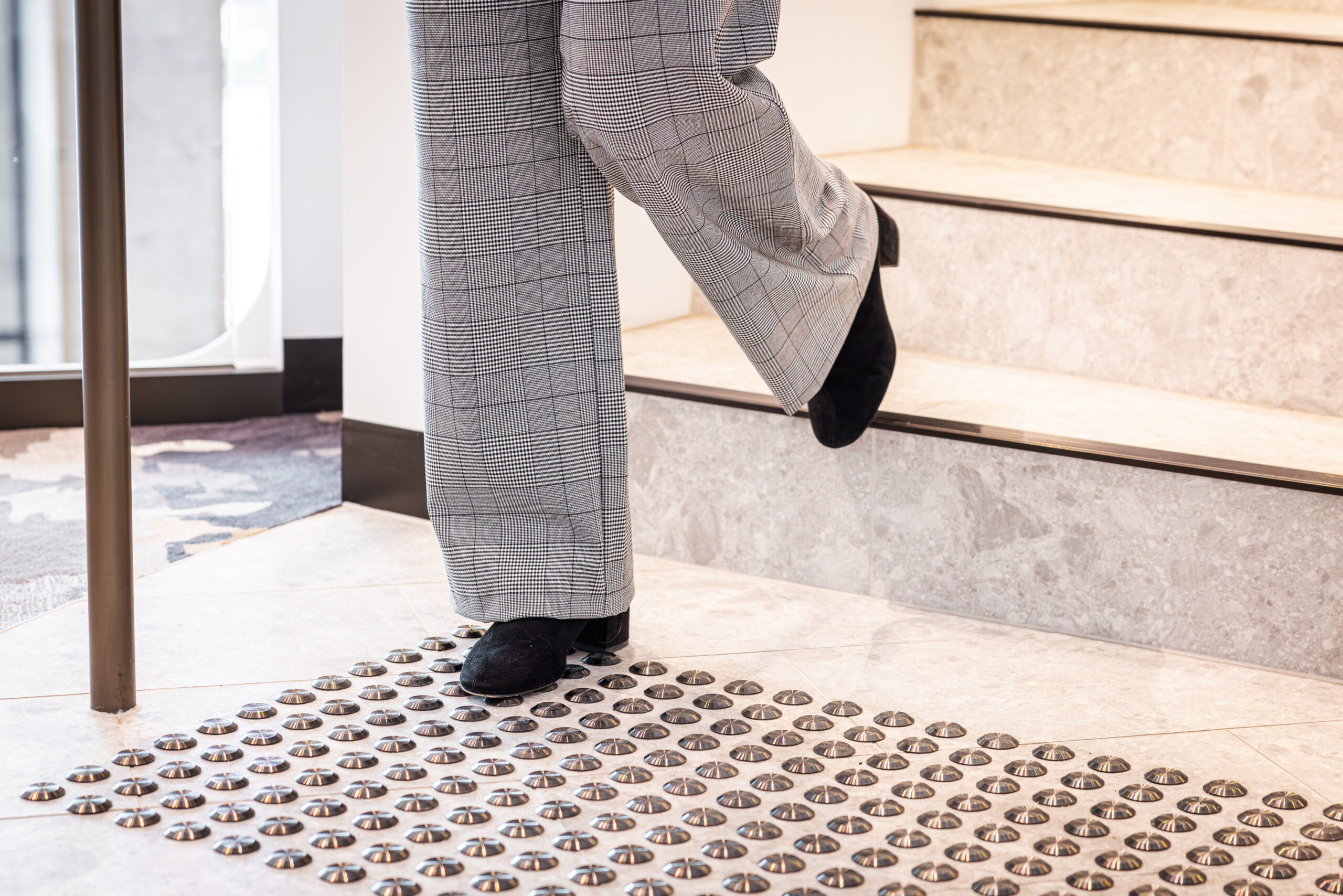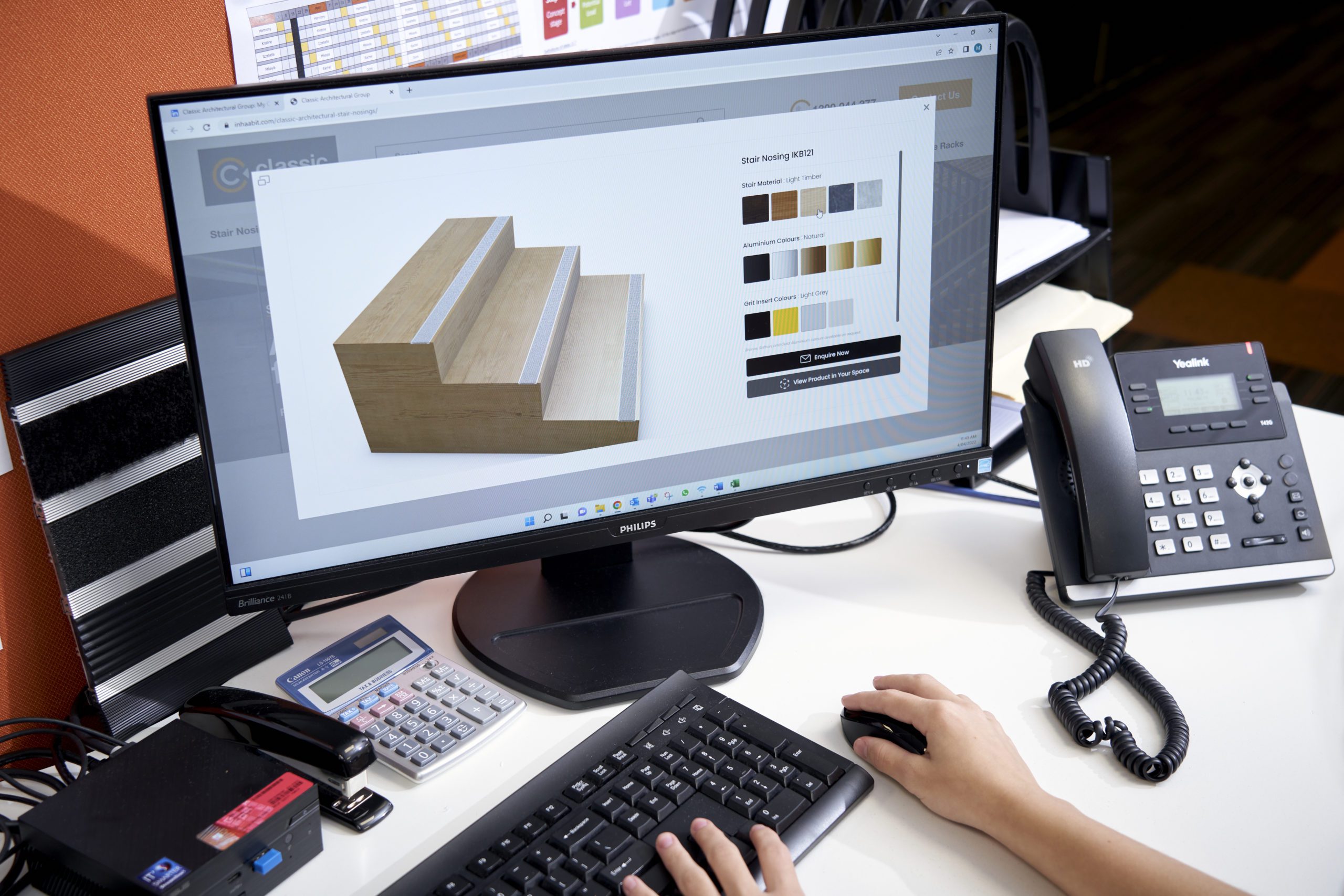Ensuring safe accessibility for visually impaired individuals in public and commercial spaces
Updated: 16 August 2024
Tactile ground surface indicators (TGSIs), commonly known as tactile indicators, are crucial navigation aids for people with vision impairments, mobility issues or other disabilities. Alongside other floor and safety features, tactile indicators are mandatory in any environment where public access is required.
Stairways, ramps, escalators, and moving walks are essential for improving traffic flow and efficiency in built environments. Still, they can pose significant challenges for individuals who are blind or have low vision.
Without proper safety and accessibility measures, these individuals are at an increased risk of slips, trips, and falls due to difficulties navigating and identifying potential hazards. If left unaddressed, this issue poses a significant concern for the estimated 453,000 Australians currently living with vision impairments — a number projected to rise to 564,000 by 2030, according to Vision Australia.
As building professionals, it is our responsibility to comply with Australian Standards and anti-discrimination laws and ensure that all community members have dignified, safe, and inclusive access.
In this article, we’ll cover the different types of tactile indicators, relevant applications, and installation guidelines in compliance with the Australian Standards for commercial spaces.
Overview of Australian Standards for Tactile Indicators (AS/NZS 1428.4.)
The built environment and high-traffic areas can be a challenge for everyday Australians to navigate, let alone those living with blindness and vision impairments.
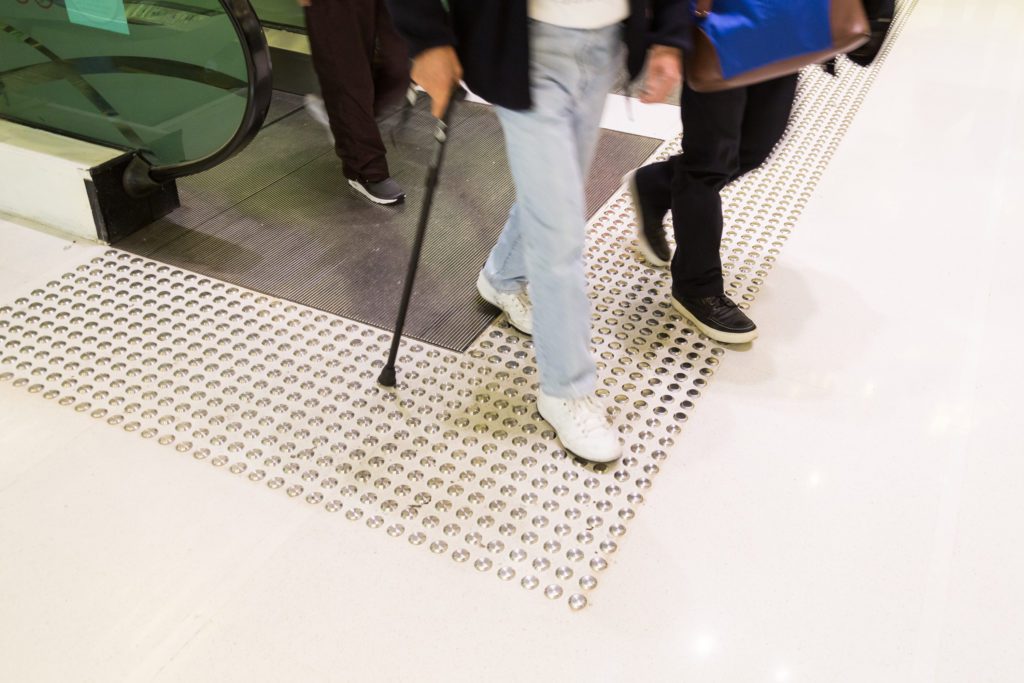
The Australian Standards have developed initiatives and guidelines for tactile indicators under AS 1428.4 to improve access and ensure equality for all.
AS/NZS 1428.4.1:2009 is the primary Australian Standard outlining tactile ground surface indicators requirements. This standard addresses the design, installation, and placement of tactile indicators to ensure consistency and compliance.
We’ll break this down in further detail below, along with all relevant Australian Standards, accessibility guidelines, and applicable laws.
Warning & Directional Tactile Indicators
There are two main types of tactile indicators: Warning Tactile Indicators and Directional Tactile Indicators.
While both types provide important directional and orientation cues for people who are blind and vision impaired, they serve slightly different but complementary purposes.
Warning Tactile Indicators
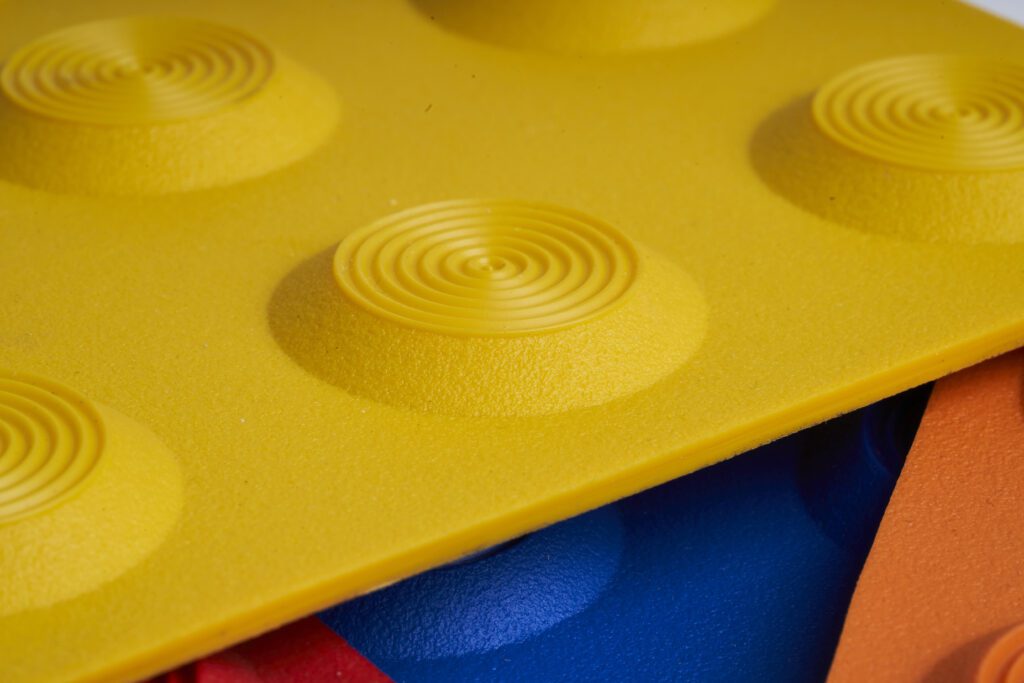
Warning tactile indicators, also called hazard tactile indicators, are textured domes installed onto walking surfaces to function as a ‘stop’ sign.
These warning TGSIs alert any pedestrians who may be blind or vision impaired of potential hazards in their path of travel, prompting them to stop and assess the situation before moving forward.
Directional Tactile Indicators

Directional or leading tactile indicators are textured features comprising directional bars installed onto walking surfaces to provide directional orientation.
These TGSIs assist blind and vision-impaired pedestrians in determining and navigating their next best accessible path of travel.
Directional tactile indicators also assist with continuous navigation, guiding people to deviate from one path of travel to another safely.
Both warning and directional tactiles are available in two different application formats:
- Individual tactiles: Installed in custom dimensions depending on the application area
- Tile or Plate format: Installed in a preset plate format of 300mm x 600mm or 300mm x 300mm for standard applications
Please download Classic’s comprehensive Tactile Indicators Compliance Guide for a complete outline.
TGSI Colour & Luminance Contrast Requirements for Safety Compliance
AS/NZS 1428.4.1:2009 further specifies requirements for the Luminance Reflectance Value (LRV) of tactile indicators.
LRV measures the contrast between tactile indicators and surrounding surfaces, ensuring optimised visibility for individuals with vision impairments.
- TGSIs must have a distinct colour and finish that contrasts effectively with adjacent surfaces for easy detectability.
- Integrated tactile indicators (plate or tile format) must meet a minimum luminance contrast standard of 30% to the floor surface.
- Single-coloured individual tactile indicators (discrete TGSIs) require a minimum of 45% contrast to the top surface.
- When using two colours of individual tactile indicators, a minimum of 60% contrast to the top surface is required.
Classic Architectural Group offers a free online LRV calculator to assess the luminance contrast value for tactile indicators and stair nosings. The calculator provides luminance contrast values for both dry and wet readings. In addition to getting instant pass or fail results, you can have a report with the outcome emailed. Try our free LRV calculator now.
Click here for more information on the importance of luminance contrast testing.
Installation Locations of Tactile Indicators in Public Areas & Commercial Spaces
The AS/NZS 1428.4.1:2009 standard for tactile indicators applies to all public and commercial environments where public access is provided.

These environments include but are not limited to:
- Public streets and sidewalks
- Pedestrian crossings
- Public transportation facilities such as train stations, bus stops, and airports
- Public buildings such as government offices, schools, hospitals, and libraries
- Recreational facilities such as parks, sports stadiums, and entertainment venues
- Commercial premises like shopping centres, malls, and retail stores
Common access points where warning tactile indicators must be installed:
- Stairways, steps and stairs
- Ramps or ramp landings
- Kerb ramps
- Escalators and moving walks
Common access points where directional tactile indicators are required:
- Public transportation access points
- Building entrances
- Kerb ramps
- Crossing points and intersections
- Open areas
- Hazardous areas
Tactile Indicator Installation Guidelines
Tactile indicators must be installed per AS/NZS 1428.4.1:2009.
While there may be variances between tiled TGSIs and individual TGSIs, here are the key points to note:
- TGSIs must be installed at a certain distance from the hazard they are indicating.
- The width of the TGSI installation must cover the entire width of the accessible path of travel.
- TGSIs should not create tripping hazards and should be securely fixed to the surface.
Other Relevant Tactile Indicator Standards
AS/NZS 1428.4.1:2009
AS/NZS 1428.4.1:2009 specifies the requirements for tactile indicators across newly constructed and renovated public or private works to optimise access and mobility in various built environments.
The standard also covers the placement of warning indicators at the top and bottom of stairs, escalators, ramps, and moving walks.
AS 4586:2013
AS 4586:2013 is the Australian Standard that sets the criteria for testing and classifying tactile indicators for appropriate slip resistance qualities.
Materials used for tactile installation must meet the slip resistance requirements outlined in the standard to ensure safe and secure footing for pedestrians, particularly in wet or slippery conditions.
National Construction Code (NCC), the Building Code of Australia (BCA) and the Disability Discrimination Act (DDA)
The Australian Standards are further reinforced by the National Construction Code (NCC), the Building Code of Australia (BCA) and the Disability Discrimination Act (DDA).
The National Construction Code (NCC) and the Building Code of Australia (BCA) incorporate Australian Standards that specify requirements for designing accessible environments, including provisions for mobility and access.
The NCC provides a uniform set of technical provisions for designing and constructing buildings and other structures across Australia. The BCA comprises chapters 1 and 2 of the NCC. Under NCC 2022, all building classifications must be accessible to people with disabilities under the relevant Australian Standards.
The Disability Discrimination Act (DDA) mandates that buildings and facilities in Australia provide reasonable access for individuals with disabilities. This includes ensuring the safety and accessibility of stairways, walkways, and communal areas. While the DDA doesn’t specify detailed requirements, it establishes the overarching goal of guaranteeing safe access for people with disabilities.
Application of Tactile Indicators in Commercial Spaces
Commercial settings often see high traffic levels, with shared access points used for efficient traffic flow and safety. However, congestion, poor lighting, and wet conditions can pose an added challenge for staff, customers, and visitors with vision impairments.

Commercial projects must be planned and set out before installation to achieve a satisfactory and compliant result per Australian Standards.
Examples of commercial spaces where tactile indicators must be installed:
- Office buildings
- Healthcare facilities
- Public transport stations and airports
- Shopping centres and retail stores
- Hotels and hospitality businesses
- Sports stadiums and entertainment venues
If TGSIs aren’t properly installed according to recommended requirements and maintenance guidelines, they can further exacerbate safety and access issues, defeating their purpose.
Furthermore, non-compliance issues can delay your development’s handover timelines and potentially lead to costly legal consequences in the future.
5 Key Benefits of Complying with Australian Standards for TGSIs
- Improved safety and accessibility for all users
- Staying on track with project timelines, preventing unexpected delays
- Legal and regulatory compliance to avoid fines and liabilities
- Enhanced reputation and inclusivity for businesses
- Boosted durability, functionality, and aesthetics of shared spaces
By ensuring compliance from day one, you’ll have peace of mind knowing that your clients and the wider community can safely access and enjoy your developments for years to come.
Classic Case Studies & Examples
Endeavour Energy
Marking a physical and cultural transition, the Endeavour Energy headquarters honours Indigenous elements while fostering a welcoming corporate environment.

Now located in the heart of Parramatta, the space ranks among Western Sydney’s most energy-efficient buildings, complementing Endeavour Energy’s reputation as one of Australia’s leading energy providers.
Working with Active Metal & Built, Classic Architectural Group customised blackened steel plates and tactile indicators to accentuate the building’s striking three-storey spiral staircase and provide a compliant solution.
Case study: Endeavour Energy
Office Works Head Office, Chadstone Place
Officeworks recently relocated its 900-strong team to the newly redeveloped Chadstone Place.

Recognised as one of Australia’s most energy-efficient office precincts, the 8,100 sqm Chadstone Place building achieved a 6-star Green Star – Design certification and an Australian-first International Living Future Institute Net Zero Carbon project certification.
Classic Architectural Group teamed with Vicinity Centres to supply and install Classic Tredfx Safety Tactile Indicators and Stair Nosings throughout the project, including the iconic staircase in the lobby. Classic also performed onsite LRV testing to ensure all installed Classic products met compliance safety standards.
Case Study: Office Works Head Office, Chadstone Place
Walsh Bay Arts Precinct
The Walsh Bay Arts Precinct has transformed into a vibrant public arts and cultural hub on Sydney’s renowned waterfront.

Since its completion, the development has received several impressive awards for its exceptional acoustics and architectural quality, including the AIA NSW Architecture Medallion, the NSW Greenway Award for Heritage Architecture, and a Public Architecture Award.
Appointed by Richard Crookes Construction, Classic supplied and installed Classic Tredfx Safety Tactile Indicators and Stair Nosings throughout the precinct, featuring products from the popular solid brass range. The brass finish perfectly complemented the building’s original timber and historical elements.
Case Study: Walsh Bay Arts Precinct
Choosing the Right Tactile Indicators for Your Commercial Project
Classic offers tactile indicators in various materials, colours, sizes, and shapes to suit all interior and exterior commercial applications.
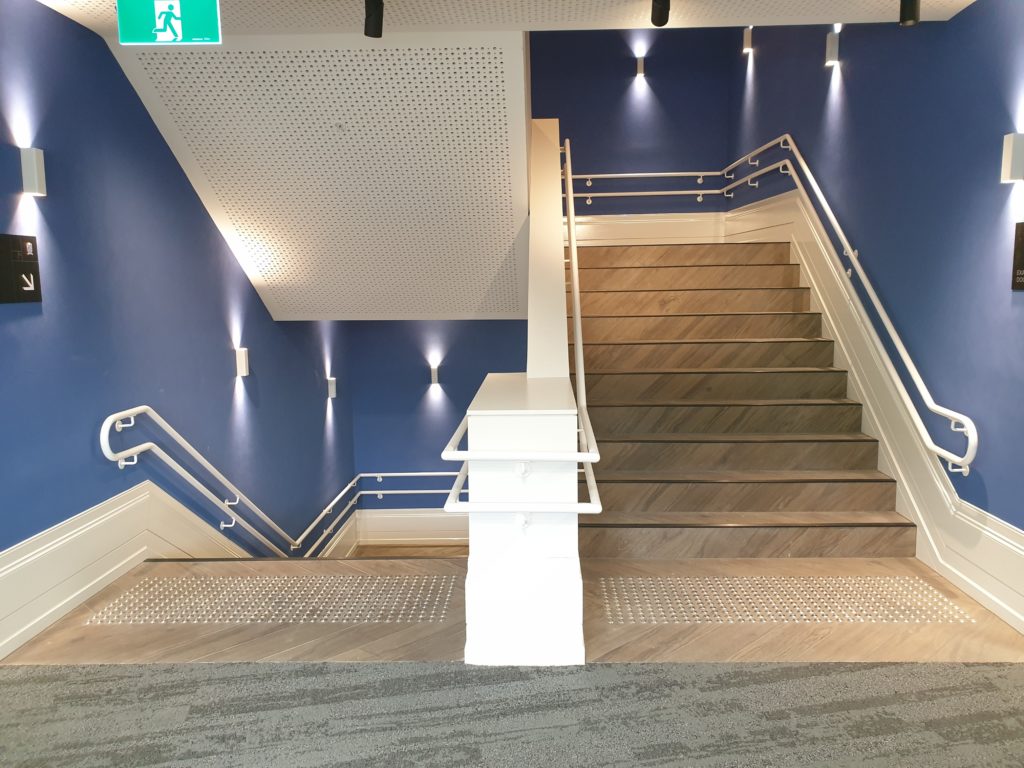
Once you’ve identified the type of tactile indicators you need (warning and/or directional) and your preferred format (individual and/or plate), you can select specific materials to meet your project’s functional and aesthetic needs. Tactile indicators can be made from any material that can endure the harsh road environment, provided they meet the dimensional and spacing requirements outlined in the Australian Standards.
Here are some of our popular tactile indicator options:
- Solid Brass Tactile Indicators — A durable and aesthetically timeless option, ideal for retrofitting interior and exterior applications.
- Stainless Steel Tactile Indicators — Offers premium durability, perfect for retrofitting existing applications across interior and exterior environments.
- Aluminium Tactile Indicators — Affordable choice for interior use, available in silver or bronze upon request.
- Polyurethane Tactile Indicators — Available in a vast range of colours and suitable for both interior and exterior use.
- Ceramic Tactile Indicators — UV-stabilised for both interior and exterior applications.
Durability and maintenance needs should also be considered to ensure longevity, especially in high-traffic commercial areas.
When selecting your preferred tactile indicators, you are welcome to use our ‘Visualise It’ 3D/AR Product Visualisation Tool to get an accurate sense of scale, depth and space.
Rely on Classic Architectural Group for High-Quality Tactile Indicators & Expert Advice

Whether accommodating vision impairment or other forms of disability, providing safe and independent access within all public and commercial spaces is non-negotiable. Challenges in navigating one’s environment can pose physical risks and negatively impact overall health and well-being.
From outdoor walking paths to new commercial developments, prioritising safety and accessibility goes beyond simply ticking a legal compliance box. It’s about creating equal, inclusive access for all Australians.
As the leading experts in compliant products and solutions across stair, floor, bike storage, bollards and car park safety, our team can assist you with determining the best tactile indicators for your commercial project.
Supporting our expansive range of architecturally designed access products, we can also provide end-to-end custom solutions, comprehensive LRV testing, and efficient installation services.
For a friendly consultation, quote or more information on any of our products, please get in touch with us by calling 1300 244 377 or emailing us at info@classic-arch.com.
Compliance Begins with Classic — Explore Our Complimentary Resources
We’ve compiled a comprehensive online Resource Hub with technical product information, installation and guides, compliance advice, and helpful tools and calculators to ensure your project’s success.

For your convenience, here are some quick links relating to this article:
- Tactile Indicators Compliance Guide — Click here for instant access
- Additional Compliance Guides — View & Download Now
- Article: Understanding the Different Types of Tactile Indicators
- Article: How to Select the Right Type of Tactile Indicators for Your Project
- Article: Adapting Your Workplace for Accessibility & Disability
